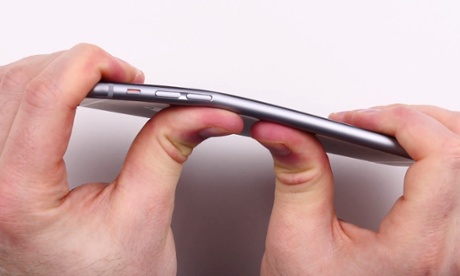
The bigger screens but thinner bodies of Apple’s new iPhone 6 and 6 Plus models have come at the cost of rigidity, according to owners who say they bent while being carried in trouser pockets.
A number of users across various forums, sites and Twitter have reported – and pictured – that their phones have become warped after they sat or bent down with them in front and rear trouser pockets.
The reports come just after an insurance company claimed that the new iPhones are the most robust ever – though its tests didn’t include bending.
The iPhone 6 and 6 Plus chassis is milled from a solid piece of aluminium alloy whose composition is secret. The weak area of the phone appears to be around the volume buttons, where the frame is at its thinnest and creates a fulcrum point around which the phone bends. Surprisingly, the screen does not break when the phone bends – though it does if the phone is then bent back to a flat profile.
Apple is not the first to have the problem of a large-screened metal-framed smartphone bending under use. Sony’s Xperia Z1, which had a 5in screen and a metal frame, saw users complaining that they bent in pockets, while Samsung Galaxy S4 users had similar complaints, as did BlackBerry Q10 users.
The exact number of iPhone 6 users affected is unknown. The Guardian found dozens of people on Twitter whose iPhone 6 or 6 Plus had bent – though there are also hundreds more echoing news reports and the pictures put up by those who have been affected.
Oups, l'iPhone 6 se déforme dans la poche ! http://t.co/szFfovaHB7 pic.twitter.com/Zru9uozhMU
— Florian Paulmier (@FlorianP123) September 23, 2014
The iPhone 6 Could Bend In Your Pocket… !! haha.. love u APPLE pic.twitter.com/MJV2s5kT1a
— Nelson Cardoz (@nelsoncardoz) September 23, 2014
Testing by Unbox Therapy showed that the iPhone 6 Plus can be bent by applying substantial force by hand.
The amount of force required to bend the smartphone is unlikely to be repeated in all but the skinniest of trousers. Before conducting the test, Lewis Hilsenteger from Unbox Therapy said his 6 Plus showed signs of being bent simply from being in his trouser pocket.
The Guardian’s testing of the phones over the past two weeks has not revealed any tendency towards deformation when normal care is taken.
Apple had not replied to request for comment by the time of publication.
Hilsenteger conducted a similar test with the 5.7in Samsung Galaxy Note 3 phablet, which warped to a lesser extent and then came back into shape due to its primarily plastic construction. The Note 3 is 2.5mm thicker than the iPhone 6 Plus, which is 7mm thick.
‘Bigger and more durable than any before them’
Reports of the phones’ bending comes as SquareTrade, which offers extended warranties on products, concluded that the new iPhones were the most robust yet in its “breakability” rating. The company put the phones through submersion in water, drops and sliding tests.
“Both new iPhones are bigger and more durable than any before them,” the SquareTrade spokesman said in the YouTube video of the company’s testing regime. “The iPhone 6 passed all of our tests with flying colours. The iPhone 6 Plus also did extremely well but it’s so big that it lost points for gripability and size, and didn’t do quiet as well in our drop test.”
A dissembling or “teardown” by repair specialists iFixit showed that Apple has made durability improvements to the iPhone 6 and 6 Plus, with rubber gaskets around buttons to help prevent water and dust entering and causing damage. Other manufacturers including Sony and Samsung have made their smartphones including the Xperia Z2 and Galaxy S5 resistant to brief submersion in water. Apple hasn’t made any claims about water resistance for the new iPhones.
Smartphones bending under pressure in the pocket is not a new thing. Phones whose frames are made of metal are most susceptible and noticeable because the metal permanently deforms - rather than rebounding or snapping as plastic does.
‘Weakness of the new iPhone’
Previous iPhones, including the iPhone 4, iPhone 5 and iPhone 5S, have suffered from bending, with users complaining about the problem in 2010, 2012 and last year via Apple’s official internet forums.
But the larger and thinner the smartphone, the more likely it is to be damaged by being carried in the pocket under tension.
“In material bending, larger cross-sectional areas [thickness x width] and shorter lengths make things stronger - you can’t easily bend a cube - while the opposite makes things very easy to bend – paper is easily folded,” Jeremy Irons, a design engineer at Creative Engineering explained to Gizmodo. “The increased length and decreased thickness contribute to the weakness of the new iPhone. Strength is proportionally related to length, but strength is affected much more by changes in thickness.”
The thinner and larger the phones get the more susceptible to damage they are likely to be, regardless of how strong the materials used in the phones to reinforce them. Being thin makes large phones more pocketable, but users need to think about the stress and strain in tight pockets as they sit down, regardless of whether they carry them in the back or front pockets.
• iPhone 6 review: thinner, faster and slightly cheaper
• Apple iPhone 6 Plus: it’s a very big phone and it feels great - review

